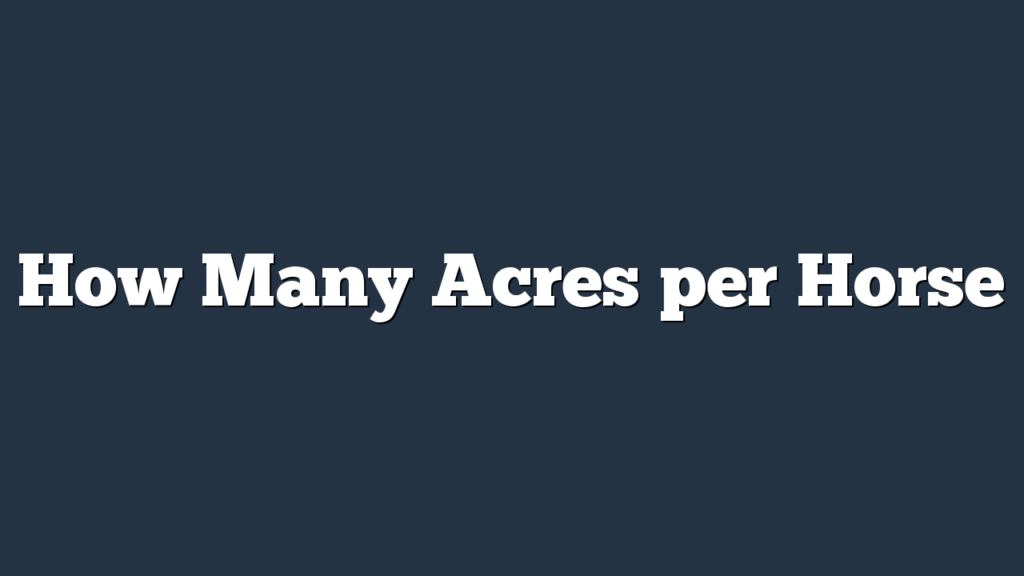Do you know how many acres you need per horse? Understanding the land requirements for your equine companion is crucial for their well-being. In this article, we will explore the factors that affect land needs, such as horse behavior, grazing and foraging needs, shelter and exercise space, and environmental factors.
By implementing proper land management techniques, you can ensure your horse has enough space to thrive. So, let’s dive in and discover how many acres per horse you should consider.
Factors Affecting Land Requirements
To determine the land requirements for your horse, you need to consider various factors affecting their needs. Two important factors to consider are fencing options and soil quality.
When it comes to fencing options, there are several choices available. You can opt for traditional wooden fences, which provide a classic look and are relatively easy to maintain. Electric fences can also be a good option, as they’re cost-effective and provide a clear boundary for your horse. However, make sure to regularly check the wiring to ensure its effectiveness. Another option is using wire mesh fences, which are sturdy and can withstand the pressure from your horse.
Moving on to soil quality, it’s crucial to assess the type and condition of the soil where your horse will be grazing. Good soil quality ensures adequate nutrition for your horse, as it affects the growth and health of the grass. Conducting soil tests can help you determine if the soil is suitable for grazing and if any amendments are needed.
Understanding Horse Behavior and Movement
Now let’s talk about how understanding horse behavior and movement can help you make informed decisions about land requirements.
By considering grazing options versus confinement, you can create an environment that supports natural behaviors and promotes overall horse well-being.
Additionally, understanding how the environment impacts horse behavior can help you optimize land usage and ensure that your horses have enough space to move and exercise comfortably.
Grazing Vs. Confinement Options
You should always consider the grazing versus confinement options for your horse, as understanding their behavior and movement is crucial.
When it comes to grazing, horses are natural foragers and require access to pasture to meet their dietary needs. Grazing allows horses to move freely, exhibit natural behaviors, and maintain a healthy weight. However, it’s important to manage land utilization efficiency to prevent overgrazing and ensure the availability of nutritious grass.
On the other hand, confinement options such as stalls or paddocks can provide a controlled environment and limit access to certain areas. This can be beneficial for horses with specific dietary requirements or those that need restricted movement due to injury.
It’s essential to balance the advantages and disadvantages of both grazing and confinement options to meet your horse’s individual needs.
Impact of Environment on Behavior
Understanding the impact of the environment on horse behavior and movement is crucial for effective horse management. The environment plays a significant role in shaping a horse’s behavior and can greatly influence their overall well-being.
One important factor to consider is the impact of nutrition on behavior. Horses that are provided with a balanced and appropriate diet are more likely to exhibit positive behaviors and have a better temperament. On the other hand, horses that are malnourished or fed an improper diet may display behavioral issues such as aggression or anxiety.
Additionally, the influence of social interactions shouldn’t be overlooked. Horses are social animals and thrive on companionship. Lack of social interaction can lead to boredom and behavioral problems. Providing horses with opportunities for socialization can greatly improve their behavior and overall quality of life.
Assessing Grazing and Foraging Needs
Assessing grazing and foraging needs begins by considering the horse’s natural habitat and dietary requirements. Horses are herbivores and have evolved to graze on a variety of grasses, plants, and shrubs. To ensure their nutritional needs are met, it’s important to evaluate their grazing patterns and provide them with adequate forage.
When assessing a horse’s grazing and foraging needs, keep in mind the following:
- Grazing patterns: Horses naturally prefer to graze for approximately 16 to 18 hours a day. They’ve a tendency to move while grazing, as this helps prevent overgrazing in one area and promotes a more balanced intake of nutrients.
- Nutritional needs: Horses require a diet that’s high in fiber, such as grass and hay, to maintain a healthy digestive system. The quality and quantity of forage should be carefully considered to ensure they receive sufficient nutrients, including carbohydrates, proteins, vitamins, and minerals.
- Variety of forage: Offering a variety of forage options, such as different types of grasses and hays, can help meet a horse’s nutritional needs and prevent boredom. This can be achieved by rotating pastures or providing access to different types of forage sources.
- Forage testing: Regularly testing the nutritional content of the forage can help identify any deficiencies or imbalances. This allows for adjustments to be made to the horse’s diet, ensuring they receive the necessary nutrients.
- Supplementation: In some cases, additional supplementation may be required to meet a horse’s specific nutritional needs. Consulting with a veterinarian or equine nutritionist can help determine if any supplements are necessary.
Evaluating Shelter and Exercise Space
When evaluating shelter and exercise space for your horse, there are a few key points to consider.
First, ensure that there’s adequate shelter available to protect your horse from harsh weather conditions.
Additionally, it’s important to provide enough exercise space for your horse to maintain its physical well-being.
Adequate Shelter Requirements
Evaluate the available shelter and exercise space to ensure it meets the adequate requirements for your horse. When assessing the shelter, consider the following key factors:
- Adequate Space: Ensure that the shelter provides enough room for your horse to comfortably move around and lie down. A cramped space can lead to stress and increased risk of injury.
- Construction Materials: Check that the shelter is constructed using durable and safe materials. Avoid structures made of flimsy materials that may not withstand harsh weather conditions or pose a danger to your horse.
- Ventilation: Adequate airflow is essential to prevent the buildup of moisture and harmful gases. Look for shelters with proper ventilation systems that allow fresh air to circulate.
- Natural Lighting: Natural light is crucial for your horse’s well-being. Opt for shelters that have windows or skylights to provide ample natural lighting during the day.
- Drainage: Ensure that the shelter has proper drainage systems in place to prevent flooding and the accumulation of standing water, which can create unsanitary conditions.
Exercise Space Considerations
To ensure your horse has enough exercise space, consider the available shelter and evaluate whether it meets the necessary requirements. The exercise space for your horse is vital for its physical and mental well-being. When evaluating the shelter, take into account the size, accessibility, and safety of the area. Additionally, consider the type of exercise equipment you have available for your horse. Outdoor options, such as pastures and paddocks, provide natural terrain and space for your horse to roam freely. On the other hand, indoor options, such as an arena or round pen, offer a controlled environment for focused training and exercise. It is important to strike a balance between outdoor and indoor options, providing your horse with both freedom and structure.
| Shelter Considerations | Outdoor Options | Indoor Options |
|---|---|---|
| Size | Spacious | Controlled |
| Accessibility | Easy access | Convenient |
| Safety | Secure | Protected |
Horse’s Physical Well-Being
Ensure your horse’s physical well-being by considering the shelter and exercise space available. Providing adequate shelter and exercise space is crucial for maintaining a healthy and happy horse. Here are some key factors to consider:
- Shelter: A suitable shelter protects your horse from extreme weather conditions, such as rain, snow, and excessive heat. It should provide ample space for your horse to move around comfortably.
- Exercise Space: Horses are active animals that require regular exercise to maintain their physical fitness. Sufficient exercise space allows your horse to run, play, and stretch its muscles.
- Mental Well-Being: Adequate shelter and exercise space contribute to your horse’s mental well-being. A comfortable and stimulating environment helps prevent boredom and reduces the risk of behavioral issues.
- Social Needs: Horses are herd animals and thrive on companionship. Providing access to other horses or suitable social interaction is vital for their emotional well-being.
- Monitoring: Regularly assess your horse’s physical and mental well-being to ensure that the shelter and exercise space provided are meeting their needs.
Considering Environmental and Climate Factors
When determining the appropriate number of acres per horse, it’s important to take into account the environmental and climate factors that can impact their well-being. Horses are highly sensitive to their surroundings, and the environmental impact can greatly affect their health and overall happiness. The availability of natural resources, such as water and forage, is crucial for their survival. If the land doesn’t have enough vegetation or water sources, it can lead to malnutrition and dehydration, negatively impacting their physical condition.
Climate conditions also play a significant role in a horse’s well-being. Extreme temperatures, whether it’s scorching hot or freezing cold, can put stress on their bodies and lead to health issues. Horses have a natural ability to regulate their body temperature, but if they’re constantly exposed to extreme weather, it can be detrimental to their health.
Additionally, the overall climate in the area can affect the quality of the land. Regions with heavy rainfall or high humidity levels can result in muddy or waterlogged pastures, which can cause hoof problems and increase the risk of diseases. On the other hand, arid climates with little rainfall can result in dry and sparse grazing areas, making it challenging for horses to find enough food.
Considering these environmental and climate factors is essential when determining the appropriate number of acres per horse. It ensures that horses have access to the resources they need to thrive and remain healthy in their environment.
Implementing Proper Land Management Techniques
Now let’s talk about how you can effectively implement proper land management techniques for your horses. Taking care of your land is crucial for the health and well-being of your horses, as well as the overall sustainability of your farm.
Here are some land management strategies and sustainable grazing practices to consider:
- Rotational grazing: Divide your pasture into smaller paddocks and rotate your horses between them. This allows the grass to recover and prevents overgrazing in certain areas.
- Fencing and water management: Ensure that your fencing is in good condition to prevent your horses from damaging the land. Additionally, provide access to clean and fresh water sources to promote hydration and reduce the impact on the land.
- Manure management: Regularly remove manure from your paddocks and pastures to prevent nutrient buildup and contamination of water sources. Consider composting your horse’s manure to create organic fertilizer for your land.
- Weed control: Implement effective weed control measures to maintain a healthy pasture. This can include mowing, hand pulling, or using herbicides as necessary.
- Soil testing and fertilization: Regularly test the soil to determine its nutrient levels and pH. Based on the results, apply appropriate fertilizers to maintain a balanced and healthy soil composition.
Frequently Asked Questions
How Much Land Is Required for a Horse if It Is Primarily Kept in a Stable?
If you primarily keep a horse in a stable, it still needs some land for exercise and grazing. Depending on supplementary feed and horse land management, a general guideline is about 1-2 acres per horse.
Can Horses Be Kept in a Smaller Area if They Are Given Supplementary Feed?
If you provide horses with supplementary feed, they can be kept in a smaller area. This benefits both you and the horses, as they have alternative grazing options and you can manage their space more efficiently.
What Are Some Common Challenges in Managing Horse Land, and How Can They Be Overcome?
When it comes to managing horse land, challenges can arise. However, with proper planning and solutions, you can overcome these obstacles. It’s important to address challenges in land management for horses to ensure their well-being.
Are There Any Specific Environmental Factors That Can Affect a Horse’s Land Requirements?
Environmental factors such as climate can greatly impact a horse’s land requirements. The type of environment, including temperature, rainfall, and vegetation, can affect the amount of land needed to support a horse’s grazing and exercise needs.
How Can Land Management Techniques Help Optimize the Use of Available Land for Horses?
To optimize land usage for horses, employ effective land management techniques. Implement strategies such as rotational grazing, pasture maintenance, and soil conservation. These practices can help maximize the available land for your horses’ needs.
Conclusion
In conclusion, when determining the number of acres per horse, it’s important to consider various factors such as:
- Horse behavior: Some horses are more active and require more space to roam, while others are content with less.
- Grazing needs: Horses require access to fresh pasture for grazing, which will affect the amount of land they need.
- Shelter and exercise space: Horses also need space for shelter and exercise, such as a stable or a fenced-in area for running.
- Environmental factors: The local climate and terrain will also impact the amount of land needed for a horse.
By implementing proper land management techniques, you can ensure that your horse has enough space for its needs. This may include rotating pastures, providing adequate shelter and exercise areas, and monitoring the condition of the land.
Remember to take into account the specific requirements of your horse and adjust the acreage accordingly. Each horse is unique, and their needs may vary based on factors such as breed, age, and health. Consulting with a veterinarian or equine specialist can help you determine the appropriate amount of land for your horse.



